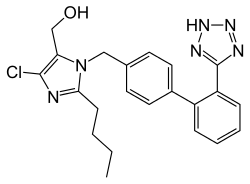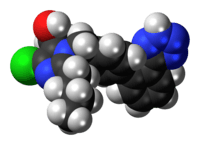Losartan
 | |
 | |
| Clinical data | |
|---|---|
| Pronunciation | /loʊˈsɑːrtən/ |
| Trade names | Cozaar, others |
| AHFS/Drugs.com | Monograph |
| MedlinePlus | a695008 |
| License data | |
| Pregnancy category | |
| Routes of administration | By mouth |
| ATC code | |
| Legal status | |
| Legal status |
|
| Pharmacokinetic data | |
| Bioavailability | 25–35% |
| Protein binding | 99.7% (primarily albumin) |
| Metabolism | Liver (CYP2C9, CYP3A4) |
| Elimination half-life | 1.5–2 hours |
| Excretion | Kidney 13–25%, biliary 50–60% |
| Identifiers | |
| |
| CAS Number | |
| PubChem CID | |
| IUPHAR/BPS | |
| DrugBank | |
| ChemSpider | |
| UNII | |
| KEGG | |
| ChEBI | |
| ChEMBL | |
| ECHA InfoCard |
100.110.555 |
| Chemical and physical data | |
| Formula | C22H23ClN6O |
| Molar mass | 422.91 g/mol |
| 3D model (JSmol) | |
| |
| |
| (verify) | |
Losartan, sold under the trade name Cozaar among others, is a medication mainly used to treat high blood pressure.[1] Other uses include for diabetic kidney disease, heart failure, and left ventricular enlargement.[1] It is taken by mouth.[1] It may be used together with other blood pressure medication.[1] Up to six weeks may be required for the full effects to occur.[1]
Common side effects include muscle cramps, stuffy nose, cough, and high blood potassium.[1] Severe side effects may include angioedema, low blood pressure, and kidney problems.[1] Use during pregnancy may result in harm to the baby.[1] Use is not recommended during breastfeeding.[2] It is in the angiotensin II receptor antagonist family of medication and works by blocking angiotensin II.[1]
Losartan was approved for medical use in the United States in 1995.[1] It is on the World Health Organization's List of Essential Medicines, the most effective and safe medicines needed in a health system.[3] It is available as a generic medication.[4] The wholesale cost in the developing world is about 0.28 USD to 3.45 USD per month as of 2015.[5] In the United States, as of 2017, the wholesale cost of a typical dose is 1.13 USD per month.[6] A version combined with hydrochlorothiazide is available.[1]
Medical uses
As with all angiotensin II type 1 receptor (AT1) antagonists, losartan is used to treat hypertension. It may also delay progression of diabetic nephropathy and is associated with a positive clinical outcome in that regard. It is a suitable pharmacological agent for the reduction of renal disease progression in patients with type 2 diabetes, hypertension, and microalbuminuria (>30 mg/24 hours) or proteinuria (>900 mg/24 hours).[7]
Although evidence shows calcium channel blockers and thiazide-type diuretics are preferred first-line treatments for most people (due to both efficacy and cost), an angiotensin II receptor antagonist such as losartan is recommended as first-line treatment in people under the age of 55 who cannot tolerate an ACE inhibitor.[8] One study demonstrated losartan was superior to atenolol in the primary prevention of adverse cardiovascular events (myocardial infarction or stroke), with a reduction in cardiovascular morbidity and mortality for a comparable reduction in blood pressure. The maximal effects on blood pressure usually occur within 3–6 weeks of starting losartan.[9]
Adverse effects
In January 2014, the FDA issued a black box warning that losartan can cause fetal toxicity, and should be discontinued as soon as pregnancy is detected.[10] Using losartan while pregnant could result in fetal injury or death.[10]
The most common side effects for losartan are upper respiratory infections or stuffy nose, dizziness, and back pain.[11] Type 2 diabetics with diabetic kidney disease may experience diarrhea, fatigue, low blood pressure, low blood glucose, elevated potassium, and chest pain.[11]
More serious side effects include low blood pressure and allergic reaction.[11]
Losartan should not be taken by people who are diabetic and taking aliskiren.[12]
Mechanism of action
Losartan is a selective, competitive angiotensin II receptor type 1 (AT1) antagonist, reducing the end organ responses to angiotensin II. Losartan administration results in a decrease in total peripheral resistance (afterload) and cardiac venous return (preload). All of the physiological effects of angiotensin II, including release of aldosterone, are antagonized in the presence of losartan. Reduction in blood pressure occurs independently of the status of the renin–angiotensin system. As a result of losartan dosing, plasma renin activity increases due to removal of the angiotensin II feedback.
Losartan is a uricosuric. As a specific inhibitor of the urate transporter 1 (SLC22A12, URAT1), losartan blocks the uptake of uric acid into cells, thus leaving more available in the bloodstream to be filtered and excreted by the kidneys.[13] Because losartan can cause hyperkalemia, individuals should not use potassium supplements or salt substitutes containing potassium without appropriate monitoring by a physician.[14]
Pharmacokinetics
Losartan is well absorbed following oral administration and undergoes significant first-pass metabolism to produce the 5-carboxylic acid metabolite, designated as EXP3174. About 14% of an oral dosage is converted to this metabolite, which is long-acting (6 to 8 hr) and a noncompetitive antagonist at the AT1 receptor, contributing to the pharmacological effects of losartan. EXP3174 is 10-40 times more potent in blocking AT1 receptors than losartan. In addition, the binding to the target enzyme is pH-sensitive, and the negatively-charged tetrazole ring, which is similar in size to the negative carboxylic acid derivative, may contribute to the activity of the drug.[15]
Losartan's bioavailability is about 32%.
Metabolism is primarily by cytochrome P450 isoenzymes CYP2C9 and CYP3A4. Peak plasma concentrations of losartan and EXP3174 occur about one hour and three to four hours, respectively, after an oral dose. Both losartan and EXP3174 are more than 98% bound to plasma proteins. Losartan is excreted in the urine, and in the feces via bile, as unchanged drug and metabolites. About 4% of an oral dose is excreted unchanged in urine, and about 6% is excreted in urine as the active metabolite. The terminal elimination half lives of losartan and EXP3174 are about 1.5 to 2.5 hours and 3 to 9 hours, respectively.
Losartan and other angiotensin-receptor antagonists exhibit fetal toxicity and should be avoided during pregnancy, particularly in the second and third trimesters.[16]
Chemistry
Losartan is generally marketed as the (basic) potassium salt of the aromatized negatively charged tetrazole, called "losartan potassium." [17]
History
References
- 1 2 3 4 5 6 7 8 9 10 11 "Losartan Potassium". The American Society of Health-System Pharmacists. Retrieved 8 December 2017.
- ↑ "Losartan (Cozaar) Use During Pregnancy". Drugs.com. Retrieved 10 December 2017.
- ↑ "WHO Model List of Essential Medicines (20th List)" (PDF). World Health Organization. March 2017. Retrieved 29 June 2017.
- ↑ British national formulary : BNF 69 (69 ed.). British Medical Association. 2015. p. 127. ISBN 9780857111562.
- ↑ "Single Drug Information". International Medical Products Price Guide. Retrieved 9 December 2017.
- ↑ "NADAC as of 2017-12-06". Centers for Medicare and Medicaid Services. Retrieved 10 December 2017.
- ↑ Boersma C, Atthobari J, Gansevoort RT, de Jong-Van den Berg LT, de Jong PE, de Zeeuw D, Annemans LJ, Postma MJ (2006). "Pharmacoeconomics of angiotensin II antagonists in type 2 diabetic patients with nephropathy: implications for decision making". PharmacoEconomics. 24 (6): 523–35. doi:10.2165/00019053-200624060-00001. PMID 16761901.
- ↑ "Hypertension in adults: diagnosis and management | 1-guidance | Guidance and guidelines | NICE". www.nice.org.uk. Retrieved 2017-04-08.
- ↑ Abrams A (2007). 'Clinical Drug Therapy Rationales for Nursing Practice. Philadelphia, Pa.: Lippincott Williams & Wilkins. p. 846. ISBN 0-7817-6263-4.
- 1 2 "Cozaar (losartan potassium) 25 mg, 50 mg, and 100 mg Tablets". fda.gov. Retrieved 2015-07-21.
- 1 2 3 "Patient Information COZAAR" (PDF). Merck.com. December 2015. Retrieved 2017-04-08.
- ↑ Merck & Co., Inc. (January 2014). "COZAAR" (PDF). U. S. Food & Drug Administratoin. Retrieved 2017-04-08.
- ↑ Hamada T, Ichida K, Hosoyamada M, Mizuta E, Yanagihara K et al. (1 October 2008). "Uricosuric action of losartan via the inhibition of urate transporter 1 (URAT 1) in hypertensive patients". 21 (10). American Journal of Hypertension: 1157–1162. doi:10.1038/ajh.2008.245.
- ↑ RxList. The Internet Drug Index. Clinical pharmacology of Cozaar. Retrieved January 6, 2014.
- ↑ Binding of losartan
- ↑ Sica DA, Gehr TW, Ghosh S (2005). "Clinical pharmacokinetics of losartan". Clin Pharmacokinet. 44 (8): 797–814. doi:10.2165/00003088-200544080-00003. PMID 16029066.
- ↑ see negatively charged tetrazole structure